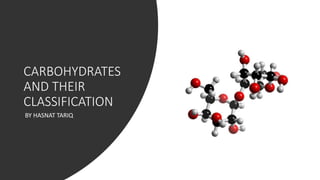
Carbohydrates and their classification
- 2. Carbohydrates • Carbohydrates are the most abundant biomolecules on Earth. • A carbohydrate is a biological molecule consisting of carbon (C), hydrogen (H) and oxygen (O) atoms, usually with a hydrogen–oxygen atom ratio of 2:1 (as in water); in other words, with the empirical formula (CH2O)n. • Carbohydrates are polyhydroxy aldehydes or ketones, or substances that yield such compounds on hydrolysis. Some carbohydrates also contain nitrogen, phosphorus, or sulfur.
- 3. Role of Carbohydrates in Living Organisms • Carbohydrates perform numerous roles in living organisms. Polysaccharides serve for the storage of energy (e.g. starch and glycogen) and as structural components (e.g. cellulose in plants and chitin in arthropods). The 5-carbon monosaccharide ribose is an important component of coenzymes (e.g. ATP, FAD and NAD) and the backbone of the genetic molecule known as RNA. The related deoxyribose is a component of DNA. Saccharides and their derivatives include many other important biomolecules that play key roles in the immune system, fertilization, preventing pathogenesis, blood clotting, and development.
- 4. Sources of Carbohydrates • Cereals • Wheat • Rice • Potatoes • Sugarcane • Fruits • Bread • Milk
- 5. Classification of Carbohydrates • There are three major size classes of carbohydrates: 1. Monosaccharides 2. Oligosaccharides 3. Polysaccharide
- 6. 1. Monosaccharides • The simplest of the carbohydrates, the monosaccharides, are either aldehydes or ketones with two or more hydroxyl groups. • Monosaccharides are colorless, crystalline solids that are freely soluble in water but insoluble in nonpolar solvents. Most have a sweet taste. • Examples of monosaccharides include glucose (dextrose), fruc tose and galactose.
- 7. 1. Monosaccharides (continue.) • The backbones of common monosaccharides are unbranched carbon chains in which all the carbon atoms are linked by single bonds. In the open-chain form, one of the carbon atoms is double-bonded to an oxygen atom to form a carbonyl group; each of the other carbon atoms has a hydroxyl group. • If the carbonyl group is at an end of the carbon chain (that is, in an aldehyde goup) the monosaccharide is an aldose. • If the carbonyl group is at any other position (in a ketone group) the monosaccharide is a ketose. • The simplest monosaccharides are the two three-carbon trioses: glyceraldehyde, an aldotriose, and dihydrorryacetone, a ketotriose.
- 8. Disaccharides • Disaccharides (such as maltose, lactose, and sucrose) consist of two monosaccharides joined covalently by an O-glycosidic bond, which is formed when a hydroxyl group of one sugar reacts with the anomeric carbon of the other. • Disaccharides can be hydrolyzed to yield their free monosaccharide components by boiling with dilute acid. N-glycosyl bonds join the anomeric carbon of a sugar to a nitrogen atom in glycoproteins and nucleotides.
- 9. 2. Oligosaccharides • Oligosaccharide, any carbohydrate of from three to six units of simple sugars (monosaccharides). • A large number of oligosaccharides have been prepared by partially breaking down more complex carbohydrates (polysaccharides). • Oligosaccharides can have many functions including cell recognition and cell binding. • Most of the few naturally occurring oligosaccharides are found in plants. Raffinose, a trisaccharide found in many plants, consists of melibiose (galactose and glucose) and fructose.
- 10. 3. Polysaccharides • Most carbohydrates found in nature occur as polysaccharides, polymers of medium to high molecular weight. • Polysaccharides, also called glycans, differ from each other in the identity of their recurring monosaccharide units, in the length of their chains, in the types of bonds Iinking the units, and in the degree of branching. • Further classified into homopolysaccharides and heteropolysaccharides.
- 11. Homopolysaccharides • Homopolysaccharides contain only a single monomeric species. • Some homopolysaccharides serve as storage forms of monosaccharides that are used as fuels; starch and glycogen are homopolysaccharides of this type. • Other homopolysaccharides (cellulose and chitin, for example) serve as structural elements in plant.
- 12. Heteropolysaccharides • Heteropolysaccharides contain two or more different kinds of monomeric species. • Heteropolysaccharides provide extracellular support for organisms of all kingdoms. For example, the rigid layer of the bacterial cell envelope (the peptidoglycan) is composed in part of a heteropolysaccharides built from two alternating monosaccharide units. • In animal tissues, the extracellular space is occupied by several types of heteropolysaccharides, which form a matrix that holds individual cells together and provides protection, shape, and support to cells, tissues, and organs.
- 13. THANK YOU
